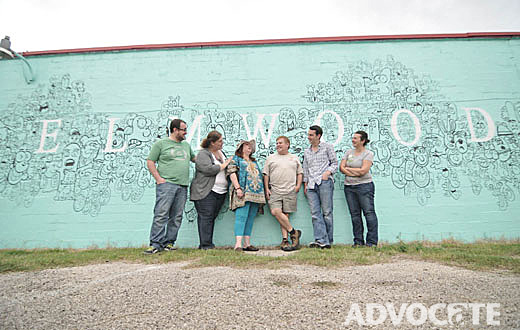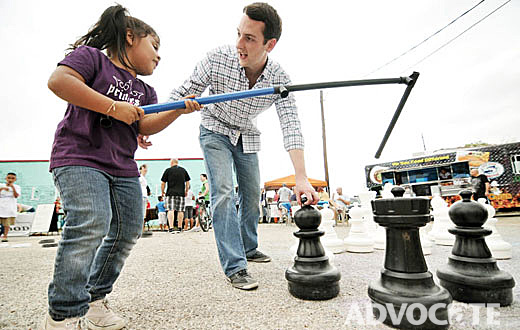
Kenneth Denson, Melissa Love-Tristan, Connie Trent Briggs, Randy Cress, Mark Lea and Karla M. Servello helped organize the Elmwood street fair last month. Photo by Can Türkyilmaz
Fresh blood is pumping through an old Oak Cliff neighborhood
Patrick McDonnell of Revolutionary Pants brought us the photos in the slideshow, above.
Elmwood is charming, and not in a perfectly coiffed Pleasantville way. Toys are sprinkled across front lawns, large trees shade car-lined streets, thriving plants draw attention away from peeling paint, and an air of community seems draped over it all.
Elmwood seems to exude life.
The neighborhood, which is bordered by Illinois, South Hampton, Wright and South Polk, is making its presence known as it seeks to attract businesses and artists, transforming itself into a cultural destination.
It feels like a small town, containing Margaret B. Henderson Elementary, a church, a business district, 1,500 homes and even a recording studio where Grammy winner Stuart Sikes and Grammy nominee John Congleton work.
Since Elmwood was developed in 1924, some things have fallen by the wayside. Vacant storefronts lie next to busy car repair and taco shops. Graffiti and tagging became commonplace for a while.
But now, things seem to be in Elmwood’s favor. Traffic and high gas prices have led to suburban residents moving closer to the city. Elmwood’s beautiful, historic homes are reasonably priced. And the neighborhood is conveniently situated with easy access to Downtown via public transportation — two DART rail stations lie near its northern border.
“Elmwood is at a tipping point,” Mark Lea says.
Lea got involved when he responded to a call from GOOD Ideas for Cities, an initiative of GOOD Magazine that asked city leaders and thinkers to propose solutions to three local challenges, one of which was the underutilization of Elmwood’s business district. Participants presented their ideas to the community in June, and though they weren’t required to take their projects further, they were encouraged to.
Lea, assistant vice president of Spire Realty Group and an avid volunteer — which is part of what led him to respond to the GOOD challenge — ended up heading the group focused on Elmwood revitalization. Brainstorming solutions, however, was not enough for him. After the presentation, he decided to help make them reality.
Though Lea lives in Uptown, he has a personal investment in the neighborhood: His grandparents’ first house was in Elmwood.
“That neighborhood is one of a kind,” Lea says. “People actually know each other and care about each other.” In a metropolitan city like Dallas, he says, “we’re not supposed to know our neighbors. We’re supposed to be flat and pretentious, and this neighborhood is none of that.”
Lea, along with the Elmwood Neighborhood Association and other interested individuals, came up with three focuses: code enforcement, beautification and immediate vibrancy. They would curb graffiti and tagging by inviting artists to paint murals on business walls. They would repave Edgefield, and put in bike lanes, lampposts, welcome signs and meandering walking trails near Cedar Creek. And they would attract restaurants, coffee shops, galleries, businesses and events.
So far, at least one business — C’s Country Cooking — has taken the bait. In late October, it took its place alongside existing businesses, which include the Edgefield Animal Clinic, Your Second Look Beauty Salon, Boy’s Taquería and El Lider USA, the only bilingual weekly in North Texas. Two existing businesses, La Fondita restaurant and Hugo’s Beer and Tacos, have expansion plans.
“You could tell the neighborhood association was really passionate but they just needed a spark, they needed to know someone was watching,” says Lea.
Assistance for all of these changes is coming from various sources. The Elmwood Neighborhood Association contributed to an October street fair that brought attention and visitors to Elmwood. District 1 councilwoman Delia Jasso helped the neighborhood secure city funds for bike lanes along Edgefield, the neighborhood’s main street. An East Dallas artist volunteered time to paint a mural along Edgefield. Lea is coughing up some of his own money, too. He hopes one of the next murals will allow for neighbors to personally fund and paint sections of the image.
“The great thing about this one is it will give people even more of a sense of ownership and will be a great way to meet others in the neighborhood,” Lea says.
Neighbors have been receptive to the revitalization project, and business owners have even shown up at neighborhood association meetings, according to Lea.
“There’s not this concrete organization,” Lea says. “There are so many people saying, ‘How can I help?’ ”
The team effort includes Karla Servello, a graphic designer getting local artists involved; Kenneth Denson, who is working with Elmwood businesses, including Hugo’s Beer and Tacos, to boost their social media presence; Melissa Love-Tristan, the unofficial “welcoming committee” for new neighbors; Connie Briggs, the code enforcement guru; and Randy Cress, president of the neighborhood association.
They have made strides in cleaning up much of the graffiti and tagging, painting murals, repaving Edgefield and organizing the street fair.
“People are starting to take pride again in the neighborhood,” Love-Tristan says.
She recently sent her new neighbors packets of chocolate, pet food samples, coupons and business cards so they could feel welcome and familiarize themselves with local businesses.
When Love-Tristan first stumbled upon the Tudor-style house she now owns, she says she knew it was meant to be. About two years ago, she drove to the airport to pick up a friend who had just seen the aftereffects of the Haiti earthquake. On their way home, they drove through neighborhoods looking at houses and people to “bring [him] back to normalhood,” Love-Tristan says. They saw people walking dogs and families with kids, and then she saw the perfect house.
“There’s something sweet here,” she says. “I can sit on the porch and watch my son ride his bike up and down the sidewalk. I love that feel of, this is a true neighborhood. There’s lots of diversity — socioeconomic, racial. People work for what they get. It’s important for our son, who’s [ethnically] mixed, to grow up seeing that.”
She sees Elmwood’s potential and wants to see it achieved, she says.
“I know it always takes a long time for change,” Love-Tristan says. “It’s a process right now.”
Since the revitalization project started, home values have gone up, according to Lea. That won’t stop Lea from moving into the neighborhood: He has his eye on an Elmwood house.
“Oak Cliff as a whole is one of a kind — but this is Elmwood’s time to shine, and they are doing it their way,” Lea says. “Sure, murals, art and restaurants aren’t unique in concept, but the involvement of the entire community, I think, is pretty special.”





